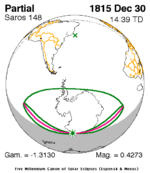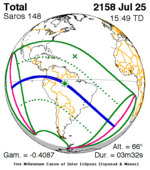

| Solar eclipse of May 20, 2050 | |
|---|---|
| Type of eclipse | |
| Nature | Hybrid |
| Gamma | −0.8688 |
| Magnitude | 1.0038 |
| Maximum eclipse | |
| Duration | 21 s (0 min 21 s) |
| Coordinates | 40°06′S 123°42′W / 40.1°S 123.7°W / -40.1; -123.7 |
| Max. width of band | 27 km (17 mi) |
| Times (UTC) | |
| Greatest eclipse | 20:42:50 |
| References | |
| Saros | 148 (23 of 75) |
| Catalog # (SE5000) | 9619 |
A total solar eclipse will occur at the Moon's descending node of orbit on Friday, May 20, 2050, with a magnitude of 1.0038. It is a hybrid event, with only a fraction of its path as total, and longer sections at the start and end as an annular eclipse. A solar eclipse occurs when the Moon passes between Earth and the Sun, thereby totally or partly obscuring the image of the Sun for a viewer on Earth. A total solar eclipse occurs when the Moon's apparent diameter is larger than the Sun's, blocking all direct sunlight, turning day into darkness. Totality occurs in a narrow path across Earth's surface, with the partial solar eclipse visible over a surrounding region thousands of kilometres wide.
This hybrid eclipse is notable in that it does not hit land anywhere on Earth.
This eclipse is a member of a semester series. An eclipse in a semester series of solar eclipses repeats approximately every 177 days and 4 hours (a semester) at alternating nodes of the Moon's orbit.[1]
The partial solar eclipses on January 26, 2047 and July 22, 2047 occur in the previous lunar year eclipse set.
| Solar eclipse series sets from 2047 to 2050 | ||||||
|---|---|---|---|---|---|---|
| Descending node | Ascending node | |||||
| Saros | Map | Gamma | Saros | Map | Gamma | |
| 118 | June 23, 2047 Partial |
1.3766 | 123 | December 16, 2047 Partial |
−1.0661 | |
| 128 | June 11, 2048 Annular |
0.6468 | 133 | December 5, 2048 Total |
−0.3973 | |
| 138 | May 31, 2049 Annular |
−0.1187 | 143 | November 25, 2049 Hybrid |
0.2943 | |
| 148 | May 20, 2050 Hybrid |
−0.8688 | 153 | November 14, 2050 Partial |
1.0447 | |
This eclipse is a part of Saros series 148, repeating every 18 years, 11 days, and containing 75 events. The series started with a partial solar eclipse on September 21, 1653. It contains annular eclipses on April 29, 2014 and May 9, 2032; a hybrid eclipse on May 20, 2050; and total eclipses from May 31, 2068 through August 3, 2771. The series ends at member 75 as a partial eclipse on December 12, 2987. Its eclipses are tabulated in three columns; every third eclipse in the same column is one exeligmos apart, so they all cast shadows over approximately the same parts of the Earth.
The longest duration of annularity will be produced by member 22 at 22 seconds (by default) on May 9, 2032, and the longest duration of totality will be produced by member 54 at 5 minutes, 23 seconds on April 26, 2609. All eclipses in this series occur at the Moon’s descending node of orbit.[2]
| Series members 10–31 occur between 1801 and 2200: | ||
|---|---|---|
| 10 | 11 | 12 |
 December 30, 1815 |
 January 9, 1834 |
 January 21, 1852 |
| 13 | 14 | 15 |
 January 31, 1870 |
 February 11, 1888 |
 February 23, 1906 |
| 16 | 17 | 18 |
 March 5, 1924 |
 March 16, 1942 |
 March 27, 1960 |
| 19 | 20 | 21 |
 April 7, 1978 |
 April 17, 1996 |
 April 29, 2014 |
| 22 | 23 | 24 |
 May 9, 2032 |
 May 20, 2050 |
 May 31, 2068 |
| 25 | 26 | 27 |
 June 11, 2086 |
 June 22, 2104 |
 July 4, 2122 |
| 28 | 29 | 30 |
 July 14, 2140 |
 July 25, 2158 |
 August 4, 2176 |
| 31 | ||
 August 16, 2194 | ||
This eclipse is a part of the long period inex cycle, repeating at alternating nodes, every 358 synodic months (≈ 10,571.95 days, or 29 years minus 20 days). Their appearance and longitude are irregular due to a lack of synchronization with the anomalistic month (period of perigee). However, groupings of 3 inex cycles (≈ 87 years minus 2 months) comes close (≈ 1,151.02 anomalistic months), so eclipses are similar in these groupings. In the 19th century:
| Inex series members between 1901 and 2100: | ||
|---|---|---|
 August 30, 1905 (Saros 143) |
 August 10, 1934 (Saros 144) |
 July 20, 1963 (Saros 145) |
 June 30, 1992 (Saros 146) |
 June 10, 2021 (Saros 147) |
 May 20, 2050 (Saros 148) |
 May 1, 2079 (Saros 149) |
||
In the 22nd century:
The metonic series repeats eclipses every 19 years (6939.69 days), lasting about 5 cycles. Eclipses occur in nearly the same calendar date. In addition, the octon subseries repeats 1/5 of that or every 3.8 years (1387.94 days). All eclipses in this table occur at the Moon's descending node.
| 21 eclipse events between May 21, 1993 and May 20, 2069 | ||||
|---|---|---|---|---|
| May 20–21 | March 9 | December 25–26 | October 13–14 | August 1–2 |
| 118 | 120 | 122 | 124 | 126 |
 May 21, 1993 |
 March 9, 1997 |
 December 25, 2000 |
 October 14, 2004 |
 August 1, 2008 |
| 128 | 130 | 132 | 134 | 136 |
 May 20, 2012 |
 March 9, 2016 |
 December 26, 2019 |
 October 14, 2023 |
 August 2, 2027 |
| 138 | 140 | 142 | 144 | 146 |
 May 21, 2031 |
 March 9, 2035 |
 December 26, 2038 |
 October 14, 2042 |
 August 2, 2046 |
| 148 | 150 | 152 | 154 | 156 |
 May 20, 2050 |
 March 9, 2054 |
 December 26, 2057 |
 October 13, 2061 |
 August 2, 2065 |
| 158 | ||||
 May 20, 2069 | ||||
This solar eclipse–related article is a stub. You can help Wikipedia by expanding it. |